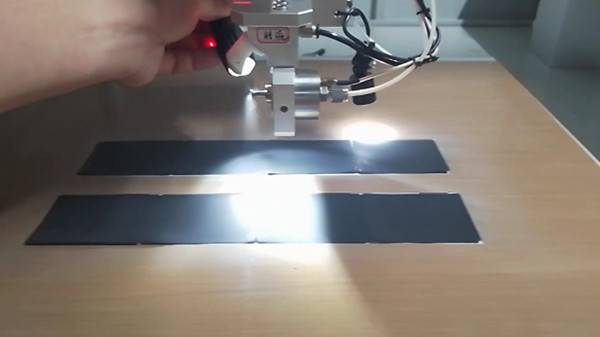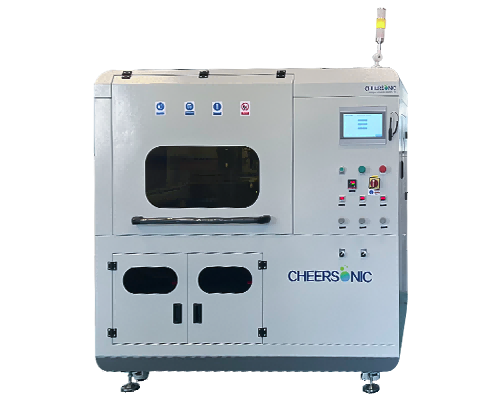CCM Preparation Process and Application of Ultrasonic Spraying
In the research and application of today’s energy field, CCM (Catalyst Coated Membrane) method, also known as catalyst coated membrane method, has become an important means of preparing key components of proton exchange membrane fuel cells with its unique advantages. It forms a highly active catalytic layer by directly coating the catalyst on both sides of the proton exchange membrane, providing strong support for the efficient operation of the fuel cell. Next, let us take a closer look at the main preparation process of the CCM method and the innovation brought by Cheersonic ultrasonic spraying technology.
I. Material preparation
(I) Proton exchange membrane
In the initial stage of CCM preparation, the selection of proton exchange membrane is crucial. We need to select proton exchange membranes with high proton conductivity, good chemical stability and excellent mechanical strength. Perfluorosulfonic acid membrane is a typical representative. Before use, pretreatment of the proton exchange membrane is indispensable. Conventional operations include steps such as cleaning and drying, the purpose of which is to thoroughly remove impurities and moisture that may exist on the membrane surface, and create a clean and stable foundation for subsequent catalyst coating.
(II) Catalysts
Catalysts are usually based on platinum-based catalysts, such as the common platinum-carbon (Pt/C) catalyst. It should be noted here that key parameters such as the particle size, specific surface area and platinum loading of the catalyst will have a significant impact on its catalytic performance. According to different application requirements and the pursuit of catalyst performance improvement, we can also choose different types of catalysts, such as alloy catalysts or core-shell structure catalysts, to enhance the activity and stability of the catalyst, so that the fuel cell can show better performance during operation.
(III) Solvents
In order to prepare catalyst slurry with excellent performance, choosing a suitable solvent is one of the key links. Alcohol solvents, such as isopropanol, ethanol, and water are commonly used. When selecting solvents, we must comprehensively consider many factors, including the solubility and volatility of the solvent on the catalyst and proton exchange membrane, as well as its possible impact on the environment, to ensure that the selected solvent meets both the preparation process requirements and the environmental protection concept.
(IV) Other additives
In order to further optimize the performance of the catalyst slurry, it is a good idea to add some additives in appropriate amounts. Binders can significantly improve the bonding force between the catalyst and the proton exchange membrane, allowing the two to be closely connected and work together; dispersants can improve the dispersion of the catalyst in the slurry, ensure the uniform distribution of the catalyst, and thus ensure the consistency of the performance of the catalyst layer.
2. Preparation of catalyst slurry
(I) Formula design
The formula of the catalyst slurry is carefully determined based on the type of catalyst, the expected loading and the specific characteristics of the proton exchange membrane. Generally, in the catalyst slurry, the mass fraction of the catalyst is controlled at 10% – 50%, the mass fraction of the binder is 1% – 10%, and the mass fraction of the dispersant is 0.1% – 1%. Reasonable formula design is the cornerstone of preparing high-quality catalyst slurry.
(II) Mixing and stirring
According to the established proportions, the catalyst, binder, dispersant and solvent are added to the stirring container together. At this time, the mixture can be stirred or ultrasonically treated with the help of a stirrer or ultrasonic equipment. In this way, the catalyst can be evenly dispersed in the solvent. The stirring time and ultrasonic treatment time are not fixed, but should be flexibly adjusted according to the type of catalyst and the viscosity of the slurry, usually in the range of a few hours to more than ten hours.
(III) Adjusting performance
After the mixing and stirring is completed, the performance of the catalyst slurry needs to be finely adjusted, such as viscosity, solid content, pH value, etc. We can accurately control the slurry performance by adding an appropriate amount of solvent or fine-tuning the content of additives to make it fully meet the stringent requirements of the subsequent coating process.
III. Coating process
(I) Direct coating method
This is a more common coating method. The proton exchange membrane is laid flat on the coating platform, and then the catalyst slurry is evenly coated on both sides of the membrane using a scraper or spray gun. In this process, the thickness and uniformity of the coating must be strictly controlled. By cleverly adjusting the height of the scraper, the pressure and flow rate of the spray gun, the ideal coating effect can be achieved. After the coating is completed, the membrane is placed in a certain temperature environment for drying to evaporate the solvent, thereby forming a stable catalytic layer.
(II) Transfer method
The operation process of the transfer method is slightly different. First, the catalyst slurry is coated on the transfer substrate. Common transfer substrates include polytetrafluoroethylene (PTFE) membrane or polyester (PET) membrane. Next, the proton exchange membrane is pressed on the transfer substrate coated with the catalyst slurry, and the catalyst is successfully transferred to both sides of the membrane by means of hot pressing or roller pressing. Finally, the transfer substrate is removed, and a proton exchange membrane coated with a catalytic layer is obtained.
IV. Post-treatment process
(I) Hot pressing treatment
Placing the proton exchange membrane coated with a catalytic layer under specific temperature and pressure conditions for hot pressing can effectively improve the bonding force between the catalyst and the proton exchange membrane. Generally, the hot pressing temperature is set at 100℃ – 200℃, the pressure is 1 – 10 MPa, and the hot pressing time ranges from a few minutes to tens of minutes.
(II) Drying treatment
After hot pressing, the proton exchange membrane is dried to completely remove residual solvents and moisture. The drying temperature is usually maintained at 80℃ – 120℃, and the drying time is about several hours to more than ten hours to ensure that the CCM finished product is in a dry and stable state.
(III) Testing and evaluation
For the prepared CCM, it is necessary to comprehensively test and evaluate its various performance indicators, covering the thickness, uniformity, platinum loading, proton conductivity, gas permeability, etc. of the catalytic layer. Based on the test results, we can accurately judge whether the preparation process is reasonable, and make targeted adjustments and optimizations to continuously improve the performance and quality of CCM.
V. Application and advantages of ultrasonic spraying in preparing CCM
In the process of continuous development of CCM preparation technology, Cheersonic innovatively introduced ultrasonic spraying technology, bringing a new revolution to this field.
(I) Application examples
Cheersonic ultrasonic spraying technology has shown excellent application value in CCM preparation. In the actual production process, the catalyst slurry can be sprayed onto the surface of the proton exchange membrane in an extremely fine and uniform manner through ultrasonic spraying equipment. For example, in a new energy research project, ultrasonic spraying was used to prepare CCM, and a catalyst layer with uniform thickness and dense structure was successfully constructed on the surface of the proton exchange membrane. Compared with the traditional coating process, the CCM prepared by this method has significantly improved proton conductivity, effectively promoted the electrochemical reaction inside the fuel cell, and significantly enhanced its output power.
(II) Unique advantages
- High-precision coating: Ultrasonic spraying can achieve precise control of the amount of catalyst slurry sprayed, with extremely small errors. This means that a catalyst layer with extremely uniform thickness can be obtained on the surface of the proton exchange membrane, effectively avoiding local performance differences caused by uneven thickness of the catalyst layer. Taking experimental data as an example, using traditional spray gun coating, the deviation of the catalyst layer thickness may reach ±10μm, while ultrasonic spraying can control the deviation within ±2μm, greatly improving the consistency of CCM quality.
- Efficient dispersion: The high-frequency vibration of ultrasound can achieve more efficient dispersion of the catalyst in the slurry. Under the traditional stirring method, some catalysts may agglomerate, affecting the catalytic activity. However, through Cheersonic ultrasonic spraying technology, the catalyst can be evenly distributed in the slurry in the form of single particles and evenly sprayed onto the proton exchange membrane, significantly improving the utilization rate of the catalyst. Studies have shown that the catalyst utilization rate of CCM prepared by ultrasonic spraying is about 20% higher than that of traditional processes. While reducing the platinum loading, it can still ensure excellent catalytic performance and effectively reduce production costs.
- Gentle coating process: The ultrasonic spraying process is relatively gentle and will not cause mechanical damage to the proton exchange membrane. Traditional scraper coating or high-pressure spray gun coating may damage the microstructure of the proton exchange membrane due to mechanical force or high-pressure impact during operation, thereby affecting its performance. The ultrasonic spraying technology sprays the catalyst slurry onto the membrane surface in a gentle manner, which well protects the original structure of the proton exchange membrane and provides a guarantee for the long-term and stable operation of the CCM.
- Good environmental adaptability: The solvents and additives used in this technology can be better mixed with the catalyst and evenly sprayed under the action of ultrasound, and have good adaptability to different types of proton exchange membranes and catalyst systems. Whether it is a perfluorosulfonic acid membrane or a new type of non-fluorinated proton exchange membrane, ultrasonic spraying can be accurately adapted, helping R&D personnel explore more innovative CCM preparation solutions and promote the continuous development of fuel cell technology.
In summary, the CCM method, as an important method for preparing key components of proton exchange membrane fuel cells, has a rigorous and sophisticated preparation process. The integration of ultrasonic spraying technology has brought many innovative advantages to CCM preparation, and is expected to further promote the development and widespread application of fuel cell technology in the future, and inject strong impetus into the green transformation of the energy field. Different research institutions and enterprises can combine Cheersonic ultrasonic spraying technology on the basis of existing processes to explore CCM preparation paths that better meet their own needs and jointly open a new chapter in energy innovation and development.
About Cheersonic
Cheersonic is the leading developer and manufacturer of ultrasonic coating systems for applying precise, thin film coatings to protect, strengthen or smooth surfaces on parts and components for the microelectronics/electronics, alternative energy, medical and industrial markets, including specialized glass applications in construction and automotive.
Our coating solutions are environmentally-friendly, efficient and highly reliable, and enable dramatic reductions in overspray, savings in raw material, water and energy usage and provide improved process repeatability, transfer efficiency, high uniformity and reduced emissions.
Chinese Website: Cheersonic Provides Professional Coating Solutions




